
If sciatica is causing you:
- Pain
- Numbness
- Or a tingling, shooting sensation
…on the outside or back of your leg–chances are, you probably need a solution AND FAST. It’s hard when physical pain stops you from functioning in your daily life. Slowing down enough to care for your body can be difficult.
But can you spare 8 minutes?
If so, read on–and I’ll show you how to get sciatica relief in 8 minutes–or less!
The Basics About Sciatica
At the end of this article, I’ll go in-depth about each of these topics, but for now, let’s start with some basic definitions:
Sciatic Nerve: A nerve that runs from your upper glutes all the way down your leg and sends signals throughout your lower back, glutes, and legs.
Sciatica: A general term for pain you feel running down your sciatic nerve. One cause of sciatica is Piriformis syndrome.
Piriformis Syndrome: When your Piriformis muscle (a deep glute muscle) tightens up, pinching your sciatic nerve and causing sciatica.
Today, we’ll focus on Piriformis Syndrome because it’s always best to start with the muscle–meaning if you can test to see if your muscle is the root cause of your issue, it can save you time and money!
4 Ways You Can Get Sciatica Relief in 8 Minutes or Less
Okay, now for the good stuff. Here are 4 ways you can experience fast relief from Piriformis Syndrome and sciatic nerve pain.
Sciatica Relief in 8 Minutes or Less Method #1: CHEMICAL RELAXERS
Approximate Time: 60 seconds
Sometimes, muscles benefit from topical chemical relaxers, which could help them take a chill pill and relax.
For example, you could try our CBD Arnica Topical Cream–an all-natural alternative to taking Tylenol or Advil for muscle relief.
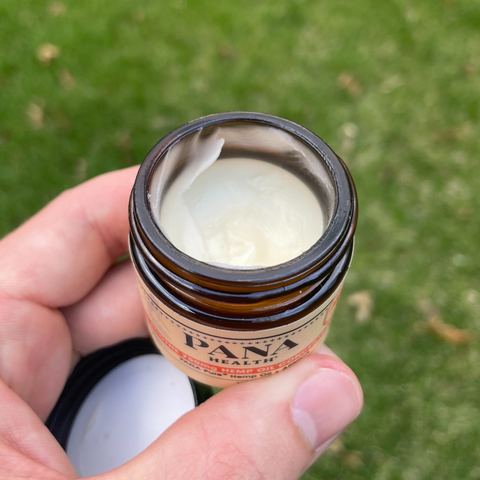
This one’s a quick solution: it takes under 60 seconds to use this stuff, but…
…Here’s the caveat: Since the Piriformis is such a deep muscle, topical chemical relaxers might not have the reach you need to experience sciatic relief in 8 minutes or less.
Sciatica Relief in 8 Minutes or Less Method #2: PIRIFORMIS MASSAGE
Approximate Time: 6 minutes or less
When your muscles are angry, the first step to help them out is always massage. Think about it: How can you stretch or strengthen muscle if it’s in an agitated state?
The best 3 types of massage for Piriformis syndrome?
One way to get this type of massage is by going to your masseuse and specifically requesting them to focus on your Piriformis muscle.
Buuut…a professional massage definitely doesn’t take 8 minutes or less. In fact, if you need sciatica relief in 8 minutes, a professional massage would have to be a no-go.
So, why did I list massage here anyway?
That’s because I recommend purchasing an at-home massage device that can target your Piriformis muscle quickly–in this case, 6 minutes or less.
The best at-home massage tool on the market–designed literally with the purpose of hitting your Piriformis–is the QL Claw.

Why is it so good, you ask?
- It’s light, yet sturdy.
- It’s stable and doesn’t move around.
- It’s purposefully designed to hit trigger points from all 5 muscles that tend to defer pain to the lower back, including your Piriformis.
If you’ve wrestled with using a golf ball to massage your Piriformis, you know how frustrating it can be when the golf ball rolls around. You also risk re-injuring the muscle if the golf ball rolls too quickly on or off the muscle.
All you have to do with the QL Claw is lie down on it. And when it comes to Piriformis release–-in less than 6 minutes per day, you’ll experience quick relief.
How to Massage Your Piriformis
Before learning how to massage the Piriformis, let’s get familiar with The Claw:
The BIG end of The Claw is called the RAMP.
The SMALL end of The Claw is called the TRIGGER.

Let’s dive in.
1) Lie down on a yoga mat on your back.
2) Place the RAMP side of The Claw under your tailbone.
3) When you do this, the TRIGGER end of The Claw should naturally hit the top of your femur/side of your hip.
4) Place both feet flat on the floor with both knees bent up to the ceiling.
5) Now, allow the working leg to fall naturally out to the side, keeping your knee slightly bent. When you do this, you’re gonna feel it in your Piriformis, so get ready for a little pain.
6) With your non-working leg, use your foot to rock your body back and forth vertically–from your head to toes. This will really get your Piriformis a good massage.
7) Massage for 60-90 seconds on each side.

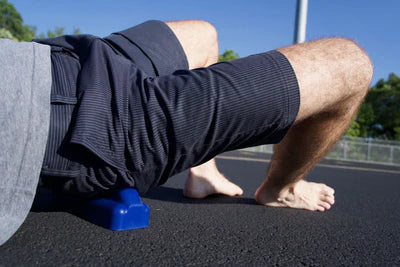
And just like that–you’ve massaged your Piriformis in 6 minutes!
Additional Pressure 1:
- Cross the working leg over the opposite knee–making a figure 4.
- Rock your body, so it tilts into and away from the trigger.
Additional Pressure 2:
- Use Additional Pressure 1 as your starting point.
- Then, use your elbows to lift up your upper body.
- Any extra weight that your upper back was taking will now shift completely to the Piriformis for an extra intense Piriformis massage.
For video instructions on how to use the QL for sciatica relief in 8 minutes or less, check out the video below:
“Piriformis Release and Stretch”
Sciatica Relief in 8 Minutes or Less Method #3: PIRIFORMIS STRETCH
Approximate Time: 8 minutes
After you’ve massaged your Piriformis for about a week, you’re chill to add in some stretches because we can assume your Piriformis has taken a breather after all that massaging.
Here are 3 Piriformis stretches to try out that’ll have you experiencing sciatica relief in 8 minutes!
Piriformis Stretch #1: Single Leg Crossover (Lying Down)
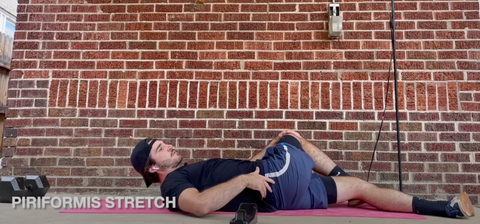
1) Lie down on your back on a yoga mat.
2) With your left hand, hold your right knee, and pull your right knee and leg over to the left side of your body–as far as it will go.
3) You can hold–or floss it–meaning hold, then release–hold, then release, etc.
4) Hold or floss for 1-2 minutes.
5) Repeat on the other side.
Piriformis Stretch #2: Seated Single-Leg Crossover

1) Sit on a seat where your thigh is parallel to the floor–no higher and no lower.
2) Straighten out your back, so it forms a 90-degree angle with your thigh.
3) Bring your right foot up onto your left knee, crossing your right leg over the left.
4) Hold for 1-2 minutes.
5) Repeat on the other side.
From this original stretch, you can add additional pressure when you:

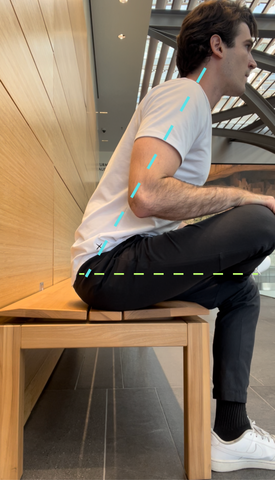
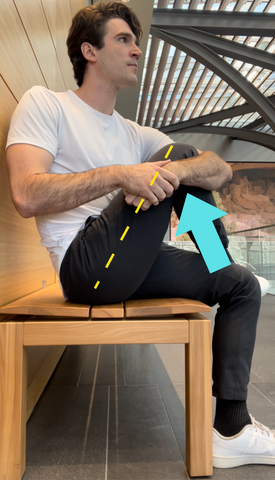
Add these stretches in, and you can be feeling 50-60% better in literally just a few days.
Within 2 weeks, your Piriformis might even completely give you and your sciatica a break, helping you feel 100% better.
For more resources on Piriformis stretches for sciatica relief in 8 minutes or less, check out the video below:
“Top 3 Piriformis Syndrome Exercises For Relief At Home”
Sciatica Relief in 8 Minutes or Less Method #4: PIRIFORMIS STRENGTHENING
Approximate Time: 8 minutes or less
So by now, you’ve:
- Massaged your Piriformis to calm down the muscle
- And stretched your Piriformis for sciatica relief
What’s next in the equation?
Strengthening for sciatica relief.
You see, if your sciatica was caused by Piriformis syndrome in the first place, then chances are–that’s because your Piriformis needs to be strengthened. With Piriformis strengthening exercises, we can build up strength for the muscle, so we lower the chances of your sciatica or Piriformis syndrome ever coming back again.
Here are some of my favorite Piriformis strengthening exercises for sciatica relief in 8 minutes or less!
Piriformis Strengthening Exercise #1: Sideline Hip Abduction
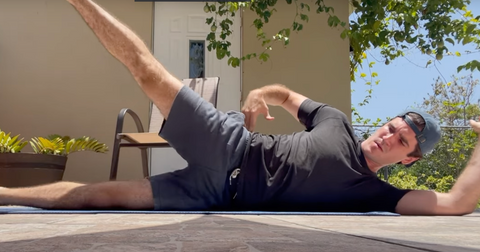
1) Lie down on your side on a yoga mat.
2) ADduct your hip–meaning bring it away from your body–by raising your upper leg.
3) Then, bring your leg back to your body.
4) Repeat for desired amount of reps.
5) Then, switch sides.
Piriformis Strengthening Exercise #2: Standing Adductor Stretch
Located on your inner thigh, your adductor muscles are antagonist muscles to the glutes (where the Piriformis is located). So when you loosen the adductors, you help your glutes and Piriformis relax.
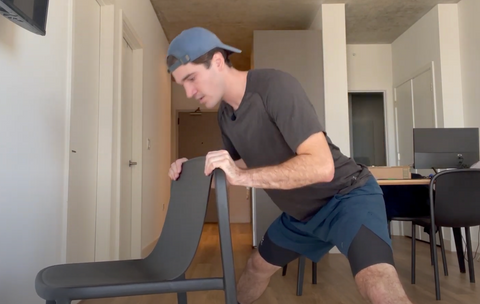
1) Set up a chair in front of you.
2) Stand facing the chair with your legs as far apart as they can go.
3) Place both hands on the chair as you bend at the waist–bringing your torso toward the top of the chair. Keep a neutral spine and flat back as you do this.
4) Release and return to the starting position.
5) Repeat for as many reps as needed.
Check out the videos below for instructions on these Piriformis exercises and more!
“3 Great Sciatica Exercises Sitting In A Chair”
“Best Exercises For Gluteus Medius & Minimus (TOP 4)”
What Is Sciatica?
Now, let’s explore the nitty-gritty science side of things. As we know, sciatica is a general term for pain you feel running down your sciatic nerve.
Some people describe sciatica as a burning pain–or even a feeling of an electric shock–running down their outer leg.
What Is Your Sciatic Nerve?
Your sciatic nerve runs from your upper glutes all the way down your leg.
When healthy, the sciatic nerve is super important–sending signals between the lower back, buttocks, and legs and allowing you to feel sensations in those areas.
The thing is: Not all of those sensations are very pleasant. So, when this nerve starts to get agitated (AKA sciatica), it can put you (and your legs, butt, and lower back) in a world of pain.
What Causes Sciatica?
Honestly, there are lots of potential causes for sciatica, but most of them come from unwanted pressure on the sciatic nerve. Here are a few examples:
- A Bulging Disk
- Bone Spurs
- Pinched Nerve
- Arthritis
- And as we know…Piriformis Syndrome
What Is Piriformis Syndrome?
Your Piriformis muscle runs from the tailbone to the femur, and it is a deep buttock muscle. In fact, it’s so deep, that it has easy access to none other than your sciatic nerve.
So, when you do something that ticks off your Piriformis muscle, it’ll tighten up and squeeze your sciatic nerve, causing sciatica.
Cue numbness and shooting, electric shock waves of pain. [1]
What Causes Piriformis Syndrome?
Piriformis syndrome can happen at any age, but typically, it sets in during your 40’s or 50’s, and it inflicts active and sedentary people alike! [1]
Most of the time, Piriformis Syndrome results from a high-stress event on the muscle itself.
For example: Let’s say you decided to get back in touch with your former athletic self–and you kicked a soccer ball around for the first time in a few years.
Or maybe you wanted to show off a little, and you bit off a bit more than you could chew when lifting something.
For your Piriformis, this could have been enough of a shocker for it to get real angry and tighten up–pinching your sciatic nerve.
Typically, you’ll start to feel sciatic pain when you sit down AFTER the high-stress event.
Looking for a test to see if you have Piriformis syndrome? Check out the article below:
“Piriformis Syndrome Test - Is Piriformis Your Pain Source?”
Also, check out the video below on ways to tell if your Piriformis is causing you sciatica.
“Is Piriformis Syndrome Causing You Sciatica?”
Sciatica Relief in 8 Minutes FAQs
How do you get immediate sciatica relief?
Immediate sciatica relief–when caused by Piriformis syndrome–comes from a routine of massaging, stretching, and strengthening your Piriformis muscle. To start, focus on massaging the Piriformis muscle for sciatica relief in 8 minutes or less.
What is the miracle stretch for sciatica?
Honestly, the best miracle stretch for sciatica is the single-leg crossover (lying down version). This is one of my favorite stretches, and it helps your Piriformis to relax a little, which could be causing your sciatica in the first place.
What makes sciatica worse?
If your sciatica stems from you lifting an object or participating in a high-stress, physical activity–continuing that activity will make your sciatica worse. Slow your roll, and pay attention to your Piriformis muscle (and explore other options) before you continue that activity.
What is the most effective pain relief for sciatica?
Deep tissue massage is the most effective pain relief for sciatica caused by Piriformis syndrome.
What relaxes the sciatic nerve?
Trigger point therapy relaxes the Piriformis, which when tight, can put crazy amounts of pressure on your sciatic nerve, resulting in sciatica.
What does severe sciatica feel like?
Severe sciatica can feel like sharp, shooting pain running down your leg–even reaching your foot. Some people describe it as electric shocks of pain.
Sources:
[1] Donnelly, Joseph M. Travell, Simons & Simons Myofascial Pain and Dysfunction: the Trigger Point Manual. 3rd ed., Wolters Kluwer Health, 2019.
[2] Ahmad Siraj S, Dadgal R. Physiotherapy for Piriformis Syndrome Using Sciatic Nerve Mobilization and Piriformis Release. Cureus. 2022 Dec 26;14(12):e32952. doi: 10.7759/cureus.32952. PMID: 36712711; PMCID: PMC9879580.
[3] https://www.ninds.nih.gov/health-information/disorders/piriformis-syndrome
[4] https://rarediseases.info.nih.gov/diseases/10026/piriformis-syndrome

